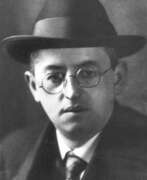Journalists Cubism


Josef Čapek was a Czech artist, writer, and journalist. He was the younger brother of writer Karel Čapek. Josef Čapek studied at the School of Applied Arts in Prague and later in Paris, where he was influenced by Cubism and Surrealism.
Čapek was a prolific artist, working in various mediums including painting, printmaking, and illustration. He is perhaps best known for his work in the area of puppetry, having created a number of puppet shows that were popular in Czechoslovakia during the 1920s and 1930s. His puppets were known for their expressive faces and whimsical designs.
Čapek was also a writer and journalist, and he wrote plays, essays, and articles for various newspapers and magazines. He was a member of the Czechoslovakian avant-garde group Devětsil, which promoted modern art and literature in the country.
During World War II, Čapek was arrested by the Nazis for his anti-fascist views and was sent to the Bergen-Belsen concentration camp. He died there in 1945, just weeks before the camp was liberated by Allied forces.
Čapek's legacy as an artist and writer is significant, and he is considered one of the most important Czech artists of the 20th century. His work is represented in many collections around the world, including the National Gallery in Prague and the Museum of Modern Art in New York.


Léon-Paul Fargue was a French poet and novelist, journalist and publicist.
Léon-Paul studied at the Lycée Henry IV in Paris and as a young man became a member of the Symbolist circle associated with Le Mercure de France. His first collection of poems was published in 1912 and reprinted in 1918. After 1930, Fargue practiced journalism almost exclusively, writing newspaper columns and lyrical essays on Parisian life.
Léon Fargue's work encompasses various literary movements, being a kind of bridge from Symbolism to Surrealism. His work has also been associated with the Dadaists and the Cubists, but he followed his own path throughout his life. Fargue was among the founders of the Nouvelle Revue Française in 1912 and participated in the first issue of the surrealist journal Literature in 1919, and was one of the leaders of the experimental journal Commerce in the 1920s. Farg was friends with many writers, artists and composers, including Pablo Picasso and Igor Stravinsky.
In 1937, Léon-Paul Fargue was elected a member of the Académie Mallarmé, and in 1946 he won the Grand Poet Laureate of Paris.